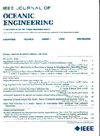基于深度平衡模型的多域信息融合舰船辐射噪声信号多标签识别方法
IF 5.3
2区 工程技术
Q1 ENGINEERING, CIVIL
引用次数: 0
摘要
船舶辐射噪声信号的识别是当前船舶感知的重要手段。许多基于深度学习技术的船舶辐射噪声信号识别方法已经被开发出来。以往的舰船辐射噪声信号识别研究都是假设单目标情况。在本文中,我们建立了船舶辐射噪声信号的多标签识别场景。提出了一种基于多域信息融合的舰船辐射噪声信号多标签识别框架。首先,我们采用两种基本骨干网络结构从时域和时频域信号数据中提取初步特征。随后,我们基于深度平衡网络理论构建了特征增强与融合模块。该模块实现了舰船辐射噪声信号的时域和时频域信息从低级到高级的信息交互。介绍了一种基于变压器的特征增强方法和一种门控融合特征更新网络结构。我们还设计了二次融合更新和域间表示的融合策略,以获得稳定的增强融合特征表示。最后,采用线性分类器确定混合信号的类别。我们使用公开可用的Deepship数据集模拟船舶辐射噪声信号的多标签数据。实验结果表明,识别效果良好。本文章由计算机程序翻译,如有差异,请以英文原文为准。
Multilabel Recognition Method for Ship-Radiated Noise Signals Based on Multidomain Information Fusion With Deep Equilibrium Models
The recognition of ship-radiated noise signals is currently the crucial means of perceiving ships. Numerous methods for the recognition of ship-radiated noise signals have been developed based on deep learning techniques. Prior studies on ship-radiated noise signal recognition have assumed a single-target scenario. In this article, we establish a multilabel recognition scenario for ship-radiated noise signals. We propose a multilabel recognition framework for ship-radiated noise signals with multidomain information fusion. Initially, we adopt two fundamental backbone network structures to extract preliminary features from both time-domain and time–frequency domain signal data. Subsequently, we construct a feature enhancement and fusion module based on the theory of deep balanced networks. This module enables information interaction from low-level to high-level between the time-domain and time-frequency domain information of ship-radiated noise signals. We introduce a transformer-based feature enhancement approach and a gated fusion feature update network structure. We also design a fusion strategy for secondary fusion updates and interdomain representations to obtain stable enhanced fusion feature representations. Finally, a linear classifier is employed to determine the categories of the mixed signals. We simulate multilabel data for ship-radiated noise signals using the publicly available Deepship data set. Experimental results demonstrate satisfactory recognition performance.
求助全文
通过发布文献求助,成功后即可免费获取论文全文。
去求助
来源期刊

IEEE Journal of Oceanic Engineering
工程技术-工程:大洋
CiteScore
9.60
自引率
12.20%
发文量
86
审稿时长
12 months
期刊介绍:
The IEEE Journal of Oceanic Engineering (ISSN 0364-9059) is the online-only quarterly publication of the IEEE Oceanic Engineering Society (IEEE OES). The scope of the Journal is the field of interest of the IEEE OES, which encompasses all aspects of science, engineering, and technology that address research, development, and operations pertaining to all bodies of water. This includes the creation of new capabilities and technologies from concept design through prototypes, testing, and operational systems to sense, explore, understand, develop, use, and responsibly manage natural resources.
 求助内容:
求助内容: 应助结果提醒方式:
应助结果提醒方式:


